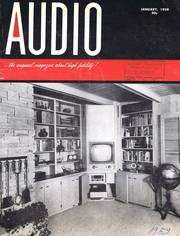Erläuterungen zu diesen US-AUDIO Seiten der 1950er Jahre
Die hier stehenden amerikanischen Artikel aus 1959 (aus der US-AUDIO) sind teilweise sehr gewöhnungsbedürftig, weil sie erstens aus einer längst vergangenen Zeit stammen und zweitens, weil dort in den USA ganz "anders" gedacht wurde als bei uns in Old Germany oder in Europa.
Vergleichbar mit unseren deutschen Hifi-Magazinen etwa ab 1962 ist jedoch, daß auch dieses Audio-Magazin ihre Anzeigen- Kunden und -Leser am Markt oder von anderen Magazinen (be- oder ab- ?) werben mußte. - Weiterhin sind die riesigen Dimensionen des amerikanischen Kontinents mit unseren hier in Europa nicht vergleichbar. - Ein Redaktions-"Trip" von New York nach Los Angeles oder Chicago oder gar in die Wüste nach Las-Vegas zu einer der CES- Audio- "Shows" war - auch mit dem Flugzeug - immer noch eine halbe Weltreise. Und jede Ausstellung oder "Messe" wurde als "Show" deklariert. Und natürlich, in USA musste alles "Show" sein, um beim Publikum einige Aufmerksamkeit zu erzeugen.
.
Die monatliche Kolumne - Editors' REVIEW - das Editorial
"STEREO QUALITY"
THERE IS QUITE A DIFFERENCE of opinion as to tile quality of stereo records, and of stereo reproduction in general. While many listeners are relatively well satisfied, some of the hypercritical ones complain loudly that stereo records do not compare in quality with the monophonic LP's. Still others - and some of the same ones - insist that no stereo effect is discernible in their listening rooms.
We must admit that not all stereo records are superlative, but we hasten to add that not all LP's were out of this world either. All the way from the original scheduling of a recording date to the issuance of pressings there are many things that can go wrong - careless or inadequately rehearsed playing, improper microphone placement, faulty tape recording, faulty transferring to master disc, trouble in processing, trouble in pressing, poor handling and packing, and on and on and on.
Any recording is subject to most of the same faults - stereo or monophonic - and the one most likely to appear only in stereo work is the matter of microphone placement.
There are many ways in which microphones may be distributed about an orchestra, and the techniques are certainly not yet reduced to a cut and dried process. It is still pretty much cut and try.
Wenn Zuhause die Phase nicht stimmt . . . .
But there is also the matter of equipment and - and don't forget it for a moment - the matter of phasing. Some months ago we were invited to the studios of a record company to hear the tapes of a new recording.
Before going into the listening room, we were told that one of the speakers wasn't right, and would we overlook it.
We listened for eight bars, concluded that the speakers were out of phase, and asked to have the music stopped.
Thirty seconds with a screwdriver to reverse one pair of wires and the "speaker" was all right again, and the tapes sounded fine.
If it is possible for those who work with music regularly - and in this case the same ones who made the original recording - to hear a playback in which one speaker is out of phase and not know what is wrong, think how much more likely the average listener is to encounter the same difficulty.
Stereo reproduction can sound horrible - or at least it can lose all the quality it should have - if the speakers are not phased properly.
Auch die Aufstellung der Boxen kann kritisch sein
And placement in the room is also important. Quite a bit of experimenting may be found necessary before one reaches the best quality and the optimum in stereo that he has a right to expect. After that, the excellent records will sound superb, and the mediocre and poor ones will sound mediocre or poor - at least it will be possible to judge records from that time on.
We will agree that a stereo system is more critical to set up and get working to the listener's complete satisfaction than any single-channel outfit. But in all fairness, remember how long and hard you worked to get your first monophonic system performing the way you wanted it to. And by the same token, remember that early LP's weren't all perfect either.
Noch ein paar Tips . . . .
From our own observations, much of the cause for complaint arises from listening to "pseudo-high-fidelity" merchandise with which the market is flooded.
People who have heard about stereo and have gone to their local appliance outlets and listened to some of the merchandise offered under the label "high fidelity" have found little to get excited about.
Two six-inch speakers 24 inches apart can never approach satisfactory stereo quality, nor will an assortment of oversized TV-quality speaker units in half-inch plywood cabinets come anywhere near to good musical reproduction.
Even if you are not in the market for a top-quality component stereo installation, at least take the trouble to condition your ears to what a good system can sound like, even if you must stick to a budget figure below what you would like.
But judging the whole field of stereo records on equipment that in itself is far from perfect is like deciding that automobiles are no good because you have just taken a ride in a 1924 Maxwell and been less than enthralled.
Not everyone needs a Rolls Royce, but make sure by trying a ride in one before yon make up your mind.
FOUR-TRACK TAPE
Nearly a year ago we read considerable publicity about a four-track tape cartridge operating at 3 3/4 ips which was expected by its originators to revolutionize the tape-playback industry, but the machines failed to reach the market.
However, the four-track idea has caught on, and performance at 7 1/2 ips has proved excellent on most of those machines so far introduced, comparing quite favorably with two-track models with respect to both quality and signal-to-noise ratio.
Undoubtedly much of the improvement in performance is the result of improved heads, which might possibly have made the two-track 7 1/2-ips tape comparable with professional single-track 15-ips tape.
Herbert L. Brown, vice-president and manager of Ampex Audio, Inc., and recently elected president of the "Magnetic Recording Industry Association", announced on May 20 that producers of recorded tapes had joined together to launch a wave of four-track stereo entertainment, and that at least 150 releases of the new tape would be forthcoming within the next few weeks.
With a number of machines available on which to play the new four-track recorded tapes, it seems likely that magnetic tape will quickly regain the position it held before the introduction of the stereo disc. While 7 1/2-ips stereo tape is better than discs, in general, it did not compare in price on a two-track basis. With four tracks it does.


